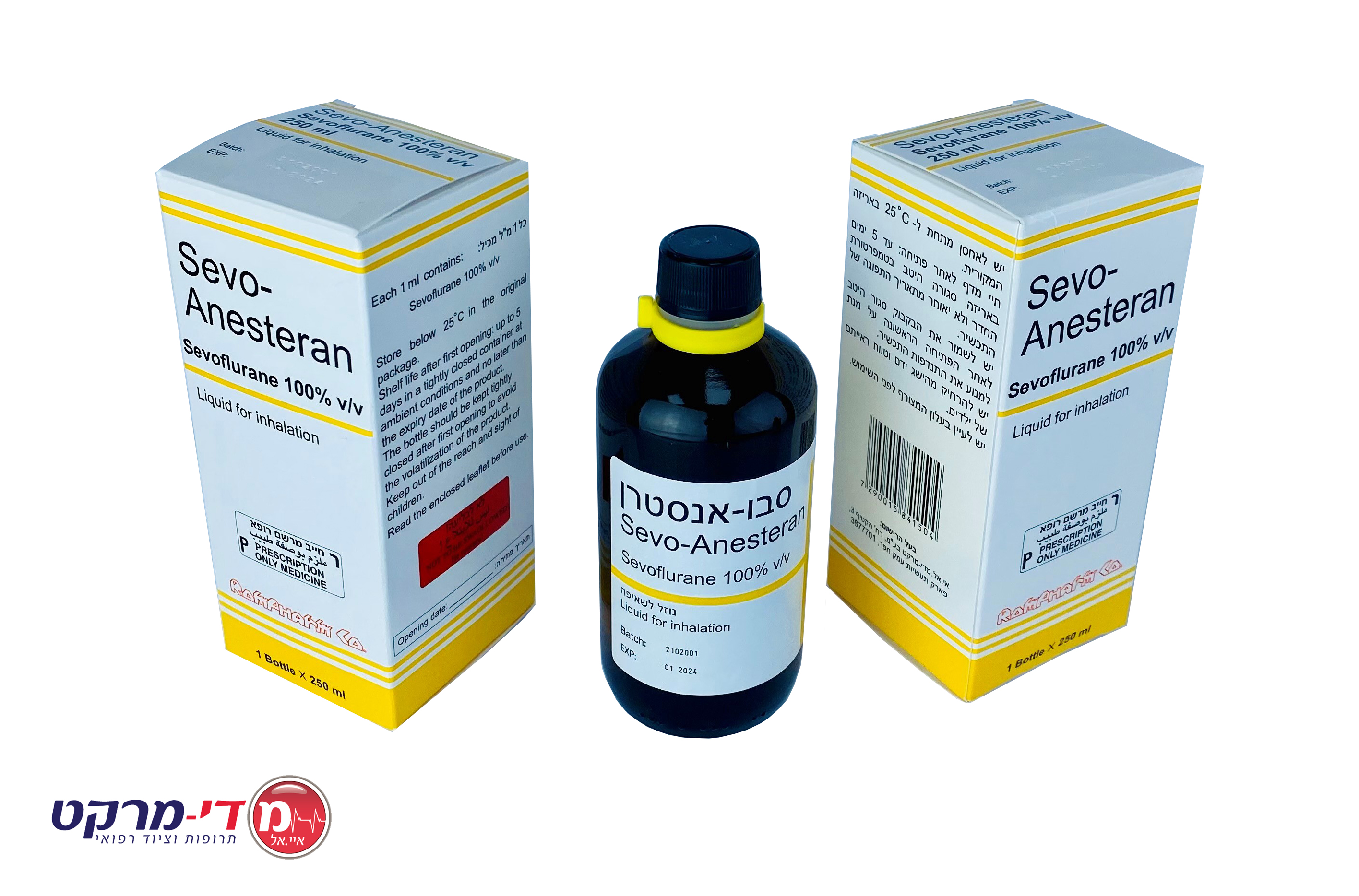Quest for the right Drug

סבו-אנסטרן SEVO - ANESTERAN (SEVOFLURANE)
תרופה במרשם
תרופה בסל
נרקוטיקה
ציטוטוקסיקה
צורת מתן:
שאיפה : INHALATION
צורת מינון:
נוזל לשאיפה : LIQUID FOR INHALATION
עלון לרופא
מינוניםPosology התוויות
Indications תופעות לוואי
Adverse reactions התוויות נגד
Contraindications אינטראקציות
Interactions מינון יתר
Overdose הריון/הנקה
Pregnancy & Lactation אוכלוסיות מיוחדות
Special populations תכונות פרמקולוגיות
Pharmacological properties מידע רוקחי
Pharmaceutical particulars אזהרת שימוש
Special Warning עלון לרופא
Physicians Leaflet
Adverse reactions : תופעות לוואי
ADVERSE REACTIONS Clinical Trials Experience Adverse events are derived from controlled clinical studies conducted in the United States, Canada, and Europe. The reference drugs were isoflurane, enflurane, and propofol in adults and halothane in pediatric patients. The studies were conducted using a variety of premedications, other anesthetics, and surgical procedures of varying length. Most adverse events reported were 29 mild and transient, and may reflect the surgical procedures, patient characteristics (including disease) and/or medications administered. Of the 5182 patients enrolled in the clinical studies, 2906 were exposed to sevoflurane, including 118 adults and 507 pediatric patients who underwent mask induction. Each patient was counted once for each type of adverse event. Adverse events reported in patients in clinical studies and considered to be possibly or probably related to sevoflurane are presented within each body system in order of decreasing frequency in the following listings. One case of malignant hyperthermia was reported in pre-registration clinical studies. Adverse Events During the Induction Period (from Onset of Anesthesia by Mask Induction to Surgical Incision) Incidence > 1% Adult Patients (N = 118) Cardiovascular Bradycardia 5%, Hypotension 4%, Tachycardia 2% Nervous System Agitation 7% Respiratory System Laryngospasm 8%, Airway obstruction 8%, Breathholding 5%, Cough Increased 5% Pediatric Patients (N = 507) Cardiovascular Tachycardia 6%, Hypotension 4% Nervous System Agitation 15% Respiratory System Breathholding 5%, Cough Increased 5%, Laryngospasm 3%, Apnea 2% Digestive System Increased salivation 2% Adverse Events During Maintenance and Emergence Periods, Incidence > 1% (N = 2906) Body as a whole Fever 1%, Shivering 6%, Hypothermia 1%, Movement 1%, Headache 1% Cardiovascular Hypotension 11%, Hypertension 2%, Bradycardia 5%, Tachycardia 2% 30 Nervous System Somnolence 9%, Agitation 9%, Dizziness 4%, Increased salivation 4% Digestive System Nausea 25%, Vomiting 18% Respiratory System Cough increased 11%, Breath holding 2%, Laryngospasm 2% Adverse Events, All Patients in Clinical Studies (N = 2906), All Anesthetic Periods, Incidence < 1% (Reported in 3 or More Patients) Body as a whole Asthenia, Pain Cardiovascular Arrhythmia, Ventricular Extrasystoles, Supraventricular Extrasystoles, Complete AV Block, Bigeminy, Hemorrhage, Inverted T Wave, Atrial Fibrillation, Atrial Arrhythmia, Second Degree AV Block, Syncope, S-T Depressed Nervous System Crying, Nervousness, Confusion, Hypertonia, Dry Mouth, Insomnia Respiratory System Sputum Increased, Apnea, Hypoxia, Wheezing, Bronchospasm, Hyperventilation, Pharyngitis, Hiccup, Hypoventilation, Dyspnea, Stridor Metabolism and Nutrition Increases in LDH, AST, ALT, BUN, Alkaline Phosphatase, Creatinine, Bilirubinemia, Glycosuria, Fluorosis, Albuminuria, Hypophosphatemia, Acidosis, Hyperglycemia Hemic and Lymphatic System Leucocytosis, Thrombocytopenia Skin and Special Senses Amblyopia, Pruritus, Taste Perversion, Rash, Conjunctivitis Urogenital Urination Impaired, Urine Abnormality, Urinary Retention, Oliguria See WARNINGS for information regarding malignant hyperthermia. 31 Post-Marketing Experience The following adverse events have been identified during post-approval use of Sevoflurane. Due to the spontaneous nature of these reports, the actual incidence and relationship of SEVO-ANESTERAN to these events cannot be established with certainty. Central Nervous System • Seizures — Post-marketing reports indicate that sevoflurane use has been associated with seizures. The majority of cases were in children and young adults, most of whom had no medical history of seizures. Several cases reported no concomitant medications, and at least one case was confirmed by EEG. Although many cases were single seizures that resolved spontaneously or after treatment, cases of multiple seizures have also been reported. Seizures have occurred during, or soon after sevoflurane induction, during emergence, and during post-operative recovery up to a day following anesthesia. • Delirium Cardiac • Cardiac arrest • QT prolongation associated with Torsade de Pointe • Bradycardia in patients with Down syndrome Hepatic • Cases of mild, moderate and severe post-operative hepatic dysfunction or hepatitis with or without jaundice have been reported. Histological evidence was not provided for any of the reported hepatitis cases. In most of these cases, patients had underlying hepatic conditions or were under treatment with drugs known to cause hepatic dysfunction. Most of the reported events were transient and resolved spontaneously (see PRECAUTIONS). • Hepatic necrosis • Hepatic failure Other • Malignant hyperthermia (see CONTRAINDICATIONS , WARNINGS) • Allergic reactions, such as rash, urticaria, pruritus, bronchospasm, and anaphylactic reactions (see CONTRAINDICATIONS) • Reports of hypersensitivity (including contact dermatitis, rash, dyspnea, wheezing, chest discomfort, swelling face, or anaphylactic reaction) have been received, particularly in association with long-term occupational exposure to inhaled anesthetic agents, including sevoflurane (see SAFETY AND HANDLING - Occupational Caution). Laboratory Findings • Transient elevations in glucose, liver function tests, and white blood cell count may occur as with use of other anesthetic agents. Reporting of suspected adverse reactions Reporting suspected adverse reactions after authorization of the medicinal product is important. It allows continued monitoring of the benefit/risk balance of the medicinal product. 32 Any suspected adverse events should be reported to the Ministry of Health according to the National Regulation by using an online form: https://sideeffects.health.gov.il

שימוש לפי פנקס קופ''ח כללית 1994
לא צוין
תאריך הכללה מקורי בסל
לא צוין
הגבלות
לא צוין
מידע נוסף
